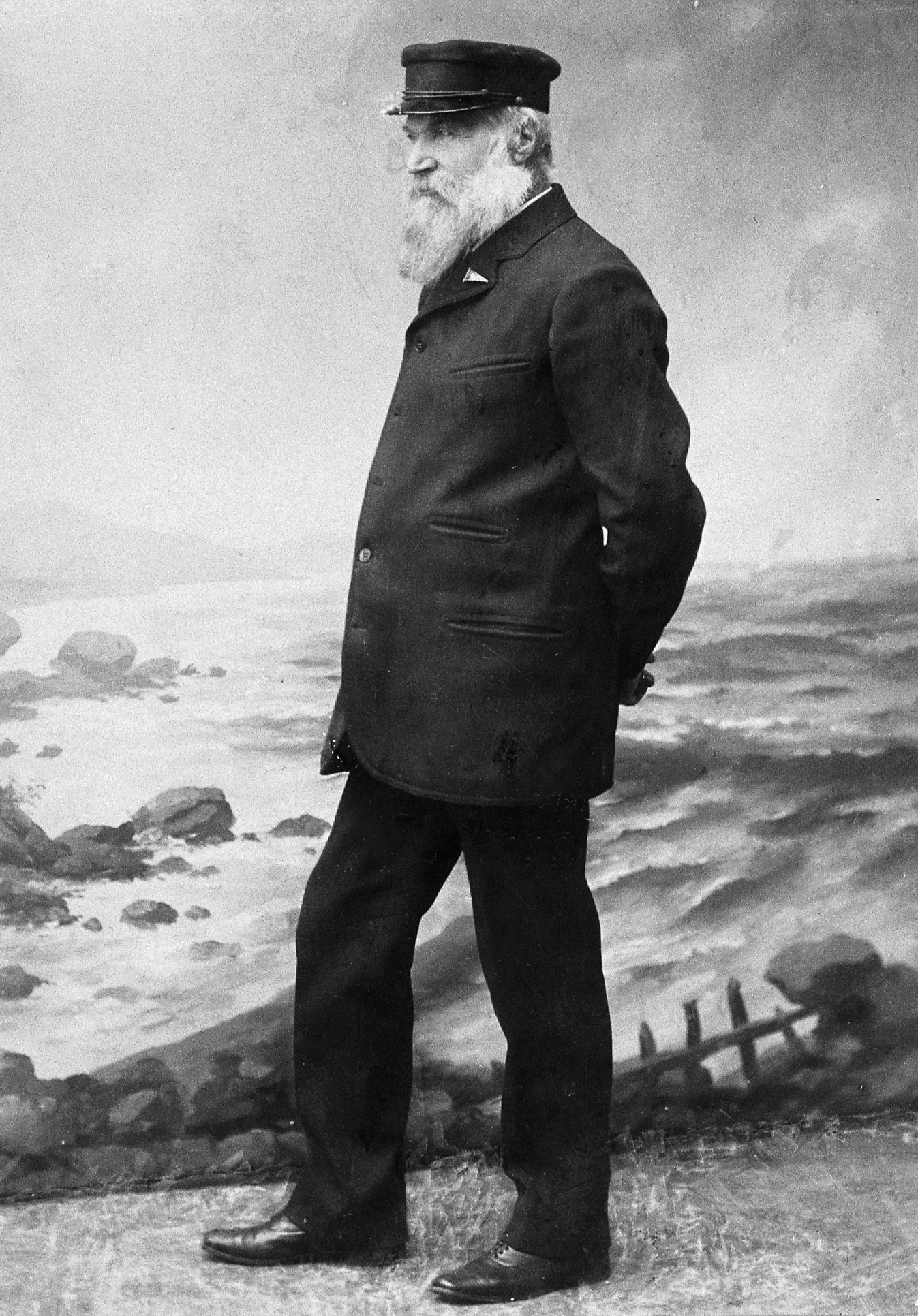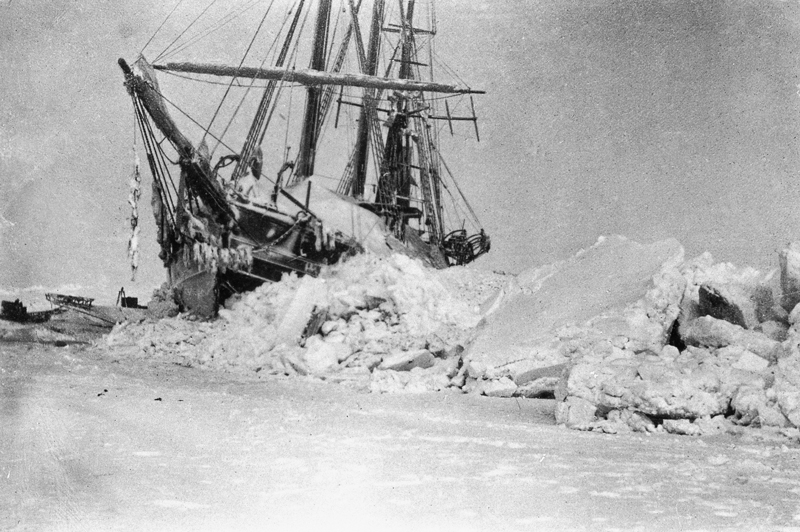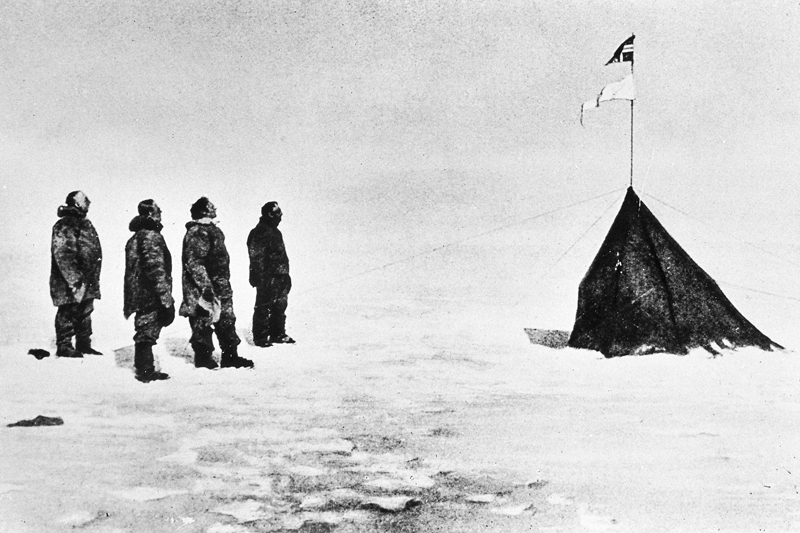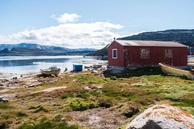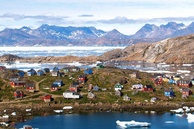In autumn 1884 Fridtjof Nansen saw an article by meteorology professor Henrik Mohn about artifacts from a wrecked American expedition ship the Jeannette which must have been carried by a current right across the Arctic Ocean. Nansen connected this theory to other finds such as the Siberian driftwood and earth that he had seen in the ice off the east coast of Greenland in 1882. He concluded that a strongly-built ship could prove the theory by drifting with the ice from east to west. He wanted several scientists along, but none would go on this 3-5 year long hazardous experiment. Nansen prepared the expedition extremely well, consulting with scientists, with experts on nutrition, with hunters and fishermen who knew about arctic sailing, and by testing and modifying equipment.
I will build a strong ship so constructed that it can withstand the pressure of the ice, and living in this ship, to float across with the ice. It will be just big enough to carry provisions for twelve men for five or six years. – Fridtjof Nansen
Fridtjof Nansen’s plan deliberately to let a ship freeze into the dreaded ice in the Arctic Ocean was revolutionary. The idea was thought to be suicidal as no ship could withstand the ice pressure. The Fram proved this wrong, but then the construction was exceptional. The main innovation was the rounded hull with smooth sides so the ice could not get a grip to press the ship down, but on the contrary would press it upwards like a round nut squeezed between two fingers. The wooden materials were stronger, thicker and more closely spaced than on any ship before. The rudder and propeller could be hoisted up inside a well in the stern to protect them from ice damage, and the ship was short, for manoeuvrability in the ice as well as for extra strength.
The Fram was built with the following specifications: length 39 m, beam 11 m, draught 5.5 m and displacement 800 tons loaded. Both the bow and the stern were particularly strengthened, with a 1.25 m thickness of oak in the bow. The sides were 70-80 cm thick and had three layers: the two inner ones of oak and the outer one of greenheart. There was only 30-40 cm between the ribs of naturally-grown knee-shaped oak bolted together in pairs. There were 400 such knees in the construction. The spaces between were filled with a mixture of pitch, tar and sawdust. The interior was in all ways supported with beams of oak and pitchpine joined with iron. The Fram was designed as a 3-masted schooner with a 34 m high main mast of pitchpine. A triple expansion steam engine of 220 hp gave a speed of 6-7 nm/hour in calm seas.
In order to start the drift near the area where the Jeannette was wrecked, the Fram was sailed through the Northeast Passage and entered the drift ice on 25 September 1893 at 77°44'N. The rudder and propeller were raised, the sails stowed away and a windmill was erected to provide electric light. Doghouses were made first on deck, later on the ice. Routines were established for daily life and for all the scientific observations and measurements. The drift northwest went very slowly due to the northerly wind, causing huge frustration for Nansen. At one time it looked as though the expedition would take eight years. Was his theory wrong? Only once was the ship threatened: 5 January 1895 the ice pressure increased and pushed huge blocks up the ship’s side and on to the deck. After a short evacuation on to the ice, the men returned to the ship. The Fram drifted to a record 85°57’N at the end of November 1895. Otto Sverdrup captained the Fram after Nansen left in March 1895 and brought her out of the ice near Svalbard 14 August 1896. They reached Skjervøy 20 August, only a week after Nansen and Johansen had reached Norway.

Roald Amundsen and the Fram
Both during the Belgian expedition with the Belgica in Antarctica 1897-99 and the expedition with the Gjøa through the Northwest Passage 1903-06, Roald Amundsen eagerly learned, practised and collected knowledge concerning travel and survival in the Polar Regions. The Gjøa stayed for two years in Gjøa Haven on King William Island, and Amundsen maintained close contact with the nomadic Inuit he met there in order to learn dog-sledge driving, igloo building, food and clothing and other adaptations to the arctic conditions. All this knowledge contributed to the ultimate success of Amundsen’s South Pole expedition 1910-12.
The South Pole Expedition
On her safe return from her last expedition, the Fram was laid up at the naval base in Horten. It was doubted for a long time whether she would ever again be used for the purpose for which she had been built, and at one time there were even plans to convert the ship into a museum.
Roald Amundsen had plans of a different kind, however. He was considering drifting across the Arctic Ocean as Nansen had done. He thought however, that if he were to sail through the Bering Strait, it would give him a better starting point and improve his chances of getting closer to the Pole. In the meantime, the American explorer Robert E. Peary´s claim to have reached the North Pole on 6 April 1909 was announced. This news fired Amundsen with a desire to make a bid for the South Pole as well, as he would in any case have to sail a long way south in order to round Cape Horn and then sail north to the Bering Strait. He took great pains to keep his decision a secret, even from his crew, which meant he had to do all the detailed planning himself.
The preparations and choice of equipment were as usual carried out with Amundsen’s great attention to detail, and the chapter in his book entitled “Plan and Equipment” could be read as a recipe for others to follow with regard to a successful polar expedition: how to protect hands and feet from frostbite, what types of skis and ski bindings should be used, which cooking stoves would function best and why, all about dog harnesses and sledge driving, of spirit compasses which freeze in the cold, and so on. Even the smallest details were taken into account.
The Fram put in at Funchal on the island of Madeira on 6 September as the last stop before Antarctica. Just before leaving three days later, Amundsen informed the crew of the change in plan, a piece of news they received with enthusiasm as their diaries confirm. His brother Leon had met them in Funchal, and he now left for Norway with letters from the crew to their families, and from Amundsen to Fridtjof Nansen, King Haakon and the newspapers explaining the change in plans.
The Fram’s voyage south took four months, which the men used to prepare and adjust equipment and to get to know the dogs. The 97 original dogs had become 116 before they reached the Bay of Whales on 14 January 1911, and even the time in the tropical zone had not affected them unduly, a large sail having been stretched over the deck to give them shade. Thorvald Nilsen had estimated that the voyage south would be 16 000 km – it turned out to be 15 938.
While in the Bay of Whales the Fram reached latitude 78°41' S, the furthest south a ship had ever penetrated. She already held the record for sailing furthest north (85° 57' N in October 1895).
A site for the base was found 4 km in from the landing place and the dogs were set to work to pull all the building materials, equipment and supplies to the site. This first dog-driving experience showed that the Alaska-type harnesses were not practical and Rønne sewed 46 new harnesses during the month before the Fram left. On 28 January the house was finished and 100 seal carcasses were stored nearby. The base was named Framheim (Fram Home) and gradually a small settlement grew up above and below the ice. Tents were erected for the dogs and for storage, and under the ice a series of rooms and connecting passages were dug out during the winter where the men had relatively comfortable conditions for their work at arranging, adjusting and packing equipment for the sledge trips.
A crucial part of Amundsen’s plan involved setting out depots along the proposed route to the Pole, and the first sledging expedition set off on 10 February to establish the first depot at 80°S. While they were away the Fram left for Buenos Aires and the oceanographic voyage in the Southern Ocean.
Before the winter set in in the middle of April, a total of 3000 kg of supplies had been left in three depots at 80°, 81° and 82°S. All the depots were clearly marked with flags in the east-west direction and cairns of snow blocks north-south. The Framheim base was completed and c. 60 000 kg of seal meat were stored there as winter food for the nine men and 115 dogs.
The winter passed quickly and easily with the continuing preparations to make the expedition equipment as optimal as possible. The sledges and equipment boxes were honed down to cut weight without compromising strength. The provisions were taken out of their cases and packed with great ingenuity to save space, sausage-shaped linen bags being sewn to pack milk powder in the holes between the round pemmican tins. Sunglasses, footwear and ski bindings were experimented on and individually chosen for greatest comfort and efficiency. The only shadow on the horizon was the worry in Amundsen’s mind that Scott might set off before him and perhaps gain greater distances with the motor sledges that he had brought along.
To the Pole
The start for the Pole was on 20 October, when Amundsen, Hanssen, Wisting, Hassel and Bjaaland set off with four sledges each pulled by 13 dogs. Amundsen had not had his own dog sledge since he had lost most of his dogs on the second, strenuous depot trip before the winter. Although the eight weeks it took them to get to the South Pole were not as easy as Amundsen perhaps portrays in his book, they did manage it without too much drama, thanks to the careful planning and preparations right from the Gjøa expedition when Amundsen and Hanssen had learned dog driving, igloo building, clothing and polar survival from the Inuit on King William Island.
Amundsen and his four companions, with the 17 remaining dogs, reached the South Pole on 14 December 1911. They spent three days in the area, taking measurements and circling the Pole with ski trips in all directions to make sure that they had covered the invisible point. They started back on the 18th, leaving a small reserve tent that Rønne had sewn standing at the Pole, and inside was a letter to Scott asking him to deliver a second letter that Amundsen had written to King Haakon stating that they had reached the goal. The idea was that Scott could bring back the message if Amundsen and his men disappeared on the way back to the coast. Amundsen also left a few unneeded objects including a sextant and some reindeer skin boots and gloves.
Amundsen and his men arrived back at Framheim on 26 January with two sledges and 11 dogs after a total absence of 99 days and a travelled distance of 3000 km. While they had been away Prestrud, Stubberud and Johansen had explored King Edward VII Land and the Fram had sailed from Buenos Aires on an oceanographic voyage across the southern Atlantic Ocean and back, collecting the first important data from this ocean area.
The Fram had arrived back at the Barrier on 9 January after a three-month voyage from Buenos Aires, but bad weather had sent them out again. She returned the day after the Pole party and on 30 January they all left. On this day Scott’s five-man group was 11 days out from the South Pole on their fatal return journey. The Fram reached Hobart in Tasmania on 7 March, remaining there until 20 March.
Amundsen left the Fram in Australia and sailed to Buenos Aires and then to Norway by faster means. When the Fram reached Buenos Aires on 25 May, Amundsen was informed that there was a chance of her becoming one of the first ships to sail through the Panama Canal. Accordingly, orders were issued to proceed to Colón, where the ship arrived on 3 October 1913.
In December as it was still not certain when the canal would be opened, the captain was ordered to set course for San Francisco round Cape Horn, it being Amundsen´s intention to continue northwards for the planned drift across the Arctic Ocean. However, one hundred days later, when they reached Buenos Aires, Amundsen countermanded his previous order and told Captain Nilsen to set course for home. The Fram returned to Horten on 16 July 1914.
When Amundsen had completed his South Pole expedition, he was still planning to continue with the original plan of a drift across the Arctic Ocean and possibly the North Pole. After preparing for two years to head north in the Framshe was now too worn to use and Amundsen had a new polar ship, the Maud, built. The Maud expedition 1918-25 was not a success for Amundsen and he left it in 1921 to use aircraft instead. The scientific leader H.U. Sverdrup continued, however, and the scientific results of the Maud expedition were impressive. Attempts with small planes in 1923 were a failure, but in 1925 Lincoln Ellsworth joined with Amundsen on an expedition with the flying boats N24 and N25 from Ny-Ålesund, Svalbard towards the North Pole. The aircraft landed in leads in the drift ice at 87°43´N and it took nearly 4 weeks of struggle to make a take-off strip in the ice so the six men could fly back to Svalbard in N25. The Amundsen-Ellsworth-Nobile Transpolar Flight with the airship Norge in 1926 was, however, a success. The flight crossed the Arctic Ocean and the North Pole from Ny-Ålesund to Teller, Alaska in 72 hours. Two years later Amundsen died with five others when their French Latham plane disappeared into the sea on the way to search for Umberto Nobile and his crashed airship the Italia.
Sources: The Fram Museum website and exhibitions.
read more in our Telegram-channel https://t.me/The_International_Affairs

 15:00 23.03.2012 •
15:00 23.03.2012 •
